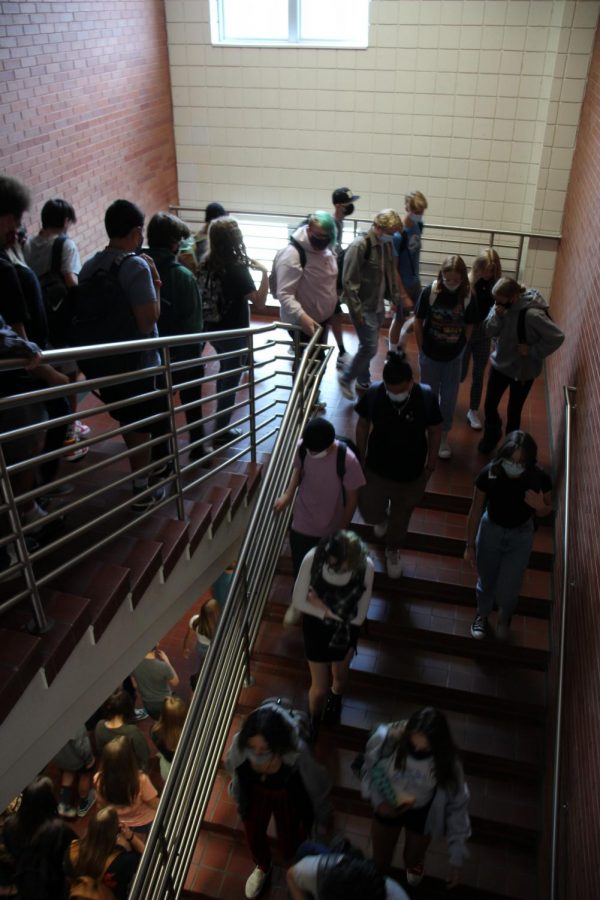Highland’s Back, More Like Highland’s Packed
September 9, 2021
Following a year of empty halls and relatively quiet corridors, the students of Highland High have returned- and then some. Anyone walking the halls (or trying to, that is), can tell that there’s something off with the sheer number of students flooding the school.
Highland has become a popular destination for students all over the valley this year, and the student body numbers are reflecting that. Highland, which usually hosts between 1,500 and 1,700 students, is currently home to a record 2,037.
With a large influx of students from the Glendale area, as well as the East, West, Skyline, and Olympus districts, the Ram Fam has grown dramatically.
But why were so many students drawn to Highland this year?
While every new student has their individual reasons for choosing Highland over other high schools in the region, Principal Jeremy Chatterton says that opportunities offered at Highland played a role in attracting students.
“We had quite a few students come for football […], probably 30 or 40.” Chatterton said.
Along with football, Chatterton says some of the new students may have been drawn by new coaches, better advertising of Highland programs, and bigger allowances for some programs. In the past, Highland has set an arbitrary level to cap acceptances into the IB program at. This year, there was no such limit.
“The real big thing is that our freshmen number is really big.” Chatterton said. “Most years we have about 500 new freshmen, but this year, for example, we are at 617.”
Regardless of why these new students chose Highland, their presence in the school is being felt by all.
Matthew Shake, a history teacher at Highland, has had his classes impacted by the high numbers of students. His largest class has 48 students in a classroom with 37 desks. And 10 folding chairs.
“We’re packed to the gills.” Shake said.
Shake says that his new approach to class is all about efficiency. With so many students, any class activity, even something as simple as taking role, becomes a drawn-out process.
“What I’ve been doing, marking role, is when the students come in, since I haven’t learned all their names yet, I just make them tell me their name and I check them off. Otherwise, role can take me 10 or 15 minutes” Shake said. “I also haven’t made a seating chart yet. There’s more students than seats.”
Though altered roll-call routines and an absence of seating charts may seem like minor changes to make, the long-term impacts of so many students in classes are going to extend well beyond that.
“If [class sizes] don’t change, the biggest long-term impacts will be on my students with IEPs [individual education plan], 504s [accommodations for individual academic needs], and my English language learners.” Shake said.
“I feel like it’s going to be harder for me to give them one on one help, which they will generally need more than other students.”
Fortunately, Shake said, his classes with IEPs, 504s, and ELLs are slightly smaller, but not by much. For students who already have hurdles to overcome in order to graduate, being in big classes where there just isn’t time to work with the teacher makes an already challenging situation even more difficult.
A bigger student body also brings up another challenge: funding.
The Salt Lake Tribune reported in May that Utah ranked #50 in the U.S. for per-student spending – making this the first year in more than two decades that Utah wasn’t ranked #51. With a large student body, lack of school funding is becoming an even bigger issue.
“We were funded for a staff for about 1,650-1,700 students.” Chatterton said. “Obviously, when we end up with 300 more students than what that is, we’re owed additional staffing. However, that won’t happen until October.”
With the district not finalizing student numbers until October, Highland will have to wait for more funding. The school is currently paying for additional classes with money fronted from discretionary funds. These funds are typically used for purchasing items throughout the year, and the Highland administration is expecting the money to be reimbursed come October 1st.
Despite the stress brought on by large class sizes, Chatterton says that problem-solving by Highland faculty and staff has been making the new student body size work.
“Teachers have been great too, in terms of coming and bringing their own ideas.” Chatterton said. “I think there’s a great energy in the building, just having students back in the building. [It] just really increases the energy everyone has; I think teachers are excited to be back as well.”




























